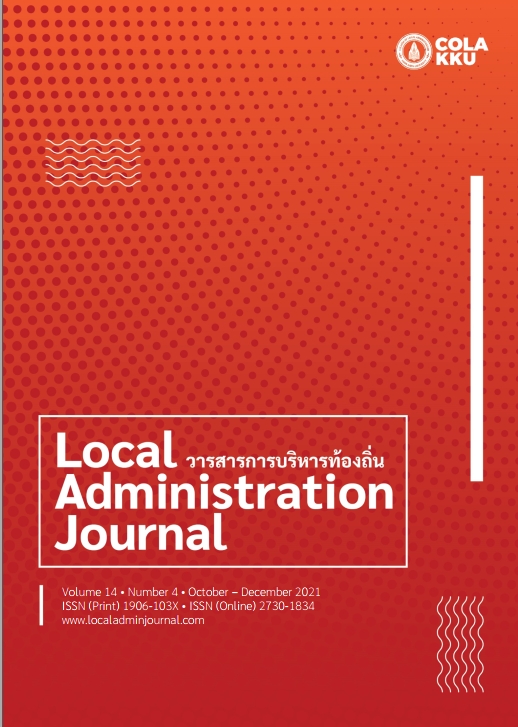อิทธิพลภาวะผู้นำแบบผู้ให้บริการของผู้จัดการสาขา ที่มีต่อวัฒนธรรมองค์การแบบสร้างสรรค์ กับประสิทธิผลของธนาคาร ตามการรับรู้ของพนักงานธนาคารเพื่อการเกษตรและสหกรณ์การเกษตร ฝ่ายกิจการสาขาภาคใต้ เพื่อการขับเคลื่อนประเทศสู่โมเดลไทยแลนด์ 4.0
DOI:
https://doi.org/10.1234/laj.v14i4.254381คำสำคัญ:
ภาวะผู้นำแบบผู้ให้บริการ, วัฒนธรรมองค์การแบบสร้างสรรค์, ประสิทธิผลของธนาคาร, ธนาคารเพื่อการเกษตรและสหกรณ์การเกษตร, Bank for Agriculture and Agricultural Cooperative (BAAC)บทคัดย่อ
งานวิจัยนี้มีวัตถุประสงค์เพื่อทดสอบอิทธิพลภาวะผู้นำแบบผู้ให้บริการของผู้จัดการสาขาที่มีต่อวัฒนธรรมองค์การแบบสร้างสรรค์กับประสิทธิผลของธนาคาร ตามการรับรู้ของพนักงานธนาคารเพื่อการเกษตรและสหกรณ์การเกษตร ฝ่ายกิจการสาขาภาคใต้ กลุ่มตัวอย่างเป็นพนักงานธนาคารจำนวน 413 คน ได้มาโดยการสุ่มแบบแบ่งชั้น เครื่องมือวิจัยมีลักษณะเป็นแบบสอบถาม มาตรส่วนประมาณค่า 5 ระดับ วิเคราะห์ข้อมูลโดยใช้โมเดลสมการโครงสร้าง ผลการวิจัยพบว่า โมเดลสมการโครงสร้างที่พัฒนาขึ้นมีความกลมกลืนกับข้อมูลเชิงประจักษ์อยู่ในเกณฑ์ดี โดยได้ค่าสถิติ c2/df = 1.847; RMSEA = 0.045; CFI = 0.99; SRMR = 0.037; AGFI = 0.92 นอกจากนี้ ผลการวิจัยยังพบว่าภาวะผู้นำแบบผู้ให้บริการมีอิทธิพลทางตรงเชิงบวกต่อวัฒนธรรมองค์การแบบสร้างสรรค์ และภาวะผู้นำแบบผู้ให้บริการมีอิทธิพลทางตรงเชิงบวกต่อประสิทธิผลของธนาคาร ดังนั้น ผู้จัดการธนาคารควรให้ความสำคัญต่อภาวะผู้นำแบบผู้ให้บริการเพื่อพัฒนาคุณภาพการบริการ ซึ่งจะส่งผลต่อประสิทธิผลการดำเนินงานโดยรวมของธนาคารเพื่อการขับเคลื่อนประเทศสู่โมเดลไทยแลนด์ 4.0
เอกสารอ้างอิง
เอกสารอ้างอิง
ภาษาไทย
ธนาคารเพื่อการเกษตรและสหกรณ์การเกษตร. (2561). การพัฒนาอย่างยั่งยืนของ ธ.ก.ส.. สืบค้นจาก https://www.baac.or.th/csr2016/?p=573
ธรณิศ เล็กขาว และอรุษ คงรุ่งโชค. (2564). ประสิทธิผลของการจัดการหนี้สินโดยการให้สินเชื่อผ่านโครงการธนาคารประชาชนในจังหวัดสุราษฎร์ธานี. (การค้นคว้าอิสระ) บัณฑิตวิทยาลัย, มหาวิทยาลัยราชภัฏ สุราษฎร์ธานี.
บุญช่วย ศิริเกษ. (2560). การศึกษาวัฒนธรรมองค์การแบบสร้างสรรค์กับการเป็นองค์กรแห่งการเรียนรู้ในมหาวิทยาลัยมหามกุฏราชวิทยาลัย วิทยาเขตศรีล้านช้าง. วารสารสมาคมนักวิจัย, 22(2), 65–80.
ผลิน ภู่จรูญ. (2554). การจัดการธุรกิจร่วมสมัย: กรอบแนวคิดใหม่ทางการจัดการในการสร้างและพัฒนาพลวัตในการแข่งขัน. กรุงเทพฯ: เอกพิมพ์ไทย.
พีรญา ชื่นวงศ์ และวิชิต อู่อ้น. (2559). การวิเคราะห์ปัจจัยภายในองค์กรที่ส่งผลต่อประสิทธิผลองค์กรของธนาคารพาณิชย์ในประเทศไทย. วารสารสังคมศาสตร์วิชาการ, 20(1), 1 – 14.
รพีพร ทรงทอง. (2561). ภาวะผู้นำและวัฒนธรรมองค์การที่ส่งผลต่อการพัฒนาท้องถิ่น. วารสารวิจัยและพัฒนามหาวิทยาลัยราชภัฏเลย, 13(45), 103 – 114.
วรางคณา กาญจนพาที และเนตร์พัณณา ยาวิราช. (2557). ภาวะผู้นำและภาวะผู้ตามที่มีอิทธิพลต่อประสิทธิภาพองค์กร กรณีศึกษา: ธนาคารเพื่อการส่งออกและนำเข้าแห่งประเทศไทย. วารสารวิชาการคณะบริหารธุรกิจ, 9(2), 59 – 68.
สุภัตรา กันพร้อม ไชยนันท์ ปัญญาศิริ และดุษฎี สีวังคำ. (2561). ประสิทธิผลการจัดการระบบสารสนเทศของธนาคารอิสลามแห่งประเทศไทย. วารสารดุษฎีบัณฑิตทางสังคมศาสตร์, 8(2), 16 – 27.
ภาษาอังกฤษ
Coetzer, F. M., Bussin, H. R., & Geldenhuys, M. (2017). Servant leadership and work-related well-being in a construction company. SA Journal of Industrial Psychology. 43(1), 1 – 10.
Cooke, R. A. & Lafferty, J. C. (2003). Organizational culture inventory, human synergistics. Plymouth, MI.
Cooper, D. R., Schindler, P. S. & Sun, J. (2006). Business research methods (9th ed.). New York: Mcgaw-Hill.
Daft, R. L. (2015). Organization theory and design (12th ed). Cincinnati: South-western.
Gibson,J. L., Ivancevich, J. M., Donnelly, J. H., Jr., & Konopaske, R. (2012). Organizations: Behavior, structure, processes (14th ed.). New York: McGraw-Hill.
Greenberg, J., & Baron, R. A. (2008). Behavior in organizations. Upper Saddle River, New Jersey: Prentice Hall.
Greenleaf, R. K. (2003). The servant - leader within: A transformative path. New York: Paulist Press.
Harwiki, W. (2013). The influence of servant leadership on organization culture, organization commitment, organization citizen behavior and employee’s performance (study of outstanding cooperative in East Java province, Indonesia). Journal of Business and Management, 8(5), 50 – 58.
Hoy, W. K., & Miskel, C. G. (2013). Educational administration theory, research, and practice (9th ed.). New York: McGraw-Hill.
Kline, R. B. (2016). Principles and practice of structural equation modeling (4th ed.). New York: The Guilford Press.
Laub, J. A. (2004). Defining servant leadership: A recommended typology for servant._Proceedings2004laub_defining_servantpdf. [Online] Available form: http://www.regent.edu/acad/global/publications/sl.University_final.pdf. [2019, October 5].
Marsh, H. W., Balla, J. R., & McDonald, R. P. (1988). Goodness-of-fit indexes in confirmatory factor analysis: The effect of sample size. Psychological Bulletin, 103(3), 391
Mbabazize, P. M., Mucunguzi, A., & Daniel, T. (2014). The importance of building organizational cultures for effective management of people and organizations: A case study of Bushenyi Local Government in Uganda. Research Journal of Sociology, 2(3), 1-12.
Nordbye, C. V. & Irving, A. J. (2017). Servant leadership and organizational effectiveness: Examining leadership culture among millennials within a US National Campus Ministry, Servant Leadership: Theory & Practice, 4(1), 53-74.
Podsakoff, P. N. (2003). Common method biases in behavioral research: A critical review of literature and recommended remedies. Journal of Applied Psychology, 88(5), 879 – 903.
Sadia, R. (2016). The relationship between employee health, quality culture and organizational effectiveness: Findings from the literature. Design & Nature and Ecodynamics, 11(1), 1–9.
Sun, Y. (2016). Does servant leadership inspire personnel’s innovation performance: Performance control as a moderator. International Journal of Business Administration. 7(2), 86 - 91.
Vondey, M. (2010). The relationships among servant leadership, organizational citizenship behavior, person- organizational fit and organizational identification. International Journal Leadership Studies, 6(1), 4 – 22.
Yukl, G. A. (2012). Leadership in organizations (8th ed.). New Jersey: Prentice-Hall.
Zehir, C., Akyuz, B., Eren, S. M. & Turhan, G. (2013). The indirect effects of servant leadership behavior on organizational citizenship behavior and job performance: Organizational justice as a mediator. International Journal of Research in Business and Social Science, 2(3), 1 – 13.
Translated References
Bank for Agriculture and Agricultural Cooperative. (2018). Sustainable development of BAAC. Retrieved from https://www.baac.or.th/csr2016/?p=5731 [2019, October, 1] (In Thai)
Cheunwong , P. & Uon, V. (2014). An analysis of internal organization factors affecting organization effectiveness of commercial bank in Thailand. Journal of Social Academic, 20(1), 1 – 14.
(In Thai)
Kanjapatee, V. & Yaviraj. N. (2014). The effect of leadership style and followership characteristics to organizational efficiency: Case study of Export Import Bank of Thailand. RMUTT Global Business and Economics Review, 9(2), 59 – 68. (In Thai)
Kanprom, S., Panyasiri, C. & Seewungkum, D. (2018). Effectiveness of information system management of the Islamic Bank of Thailand. Ph.D. in Social Sciences Journal, 8(2), 16 – 27. (In Thai)
Poojaroon, P. (2011). Contemporary business management: A new management framework for creating and developing competitive dynamics. Bangkok: Ekpimthai. (In Thai)
Sirikase, B. (2017). A Study of constructive organizational culture and learning organization in Mahamakut Buddhist University, Srilanchang Campus. Journal of the Association of Researchers, 22(2), 65 – 80. (In Thai)
Trongthong, R. (2018). The leadership and organization culture affecting local development. Research and Development Journal, Loei Rajaphat Suratthani University, 13(45),103 – 114. (In Thai)
ดาวน์โหลด
เผยแพร่แล้ว
เวอร์ชัน
- 2022-02-28 (2)
- 2021-12-30 (1)
รูปแบบการอ้างอิง
ฉบับ
ประเภทบทความ
สัญญาอนุญาต
บทความทุกเรื่องที่ได้รับการตีพิมพ์ทั้งรูปเล่มและบทความออนไลน์ เป็นลิขสิทธิ์ของวิทยาลัยการปกครองท้องถิ่น มหาวิทยาลัยขอนแก่น


